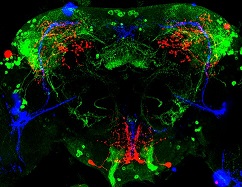
Active
View Entry | Circadian rhythm neurons in the fruit fly brain3754| Some nerve cells (neurons) in the brain keep track of the daily cycle. This time-keeping mechanism, called the circadian clock, is found in all animals including us. The circadian clock controls our daily activities such as sleep and wakefulness. Researchers are interested in finding the neuron circuits involved in this time keeping and how the information about daily time in the brain is relayed to the rest of the body. In this image of a brain of the fruit fly Drosophila the time-of-day information flowing through the brain has been visualized by staining the neurons involved: clock neurons (shown in blue) function as "pacemakers" by communicating with neurons that produce a short protein called leucokinin (LK) (red), which, in turn, relays the time signal to other neurons, called LK-R neurons (green). This signaling cascade set in motion by the pacemaker neurons helps synchronize the fly's daily activity with the 24-hour cycle.
To learn more about what scientists have found out about circadian pacemaker neurons in the fruit fly see this news release by New York University.
This work was featured in the Biomedical Beat blog post Cool Image: A Circadian Circuit. | | Public Note | | | | | Internal Note | | Researchers gave permission for public use of the image:
Justin Blau [justin.blau@nyu.edu]
Thursday, March 10, 2016 2:37 AM
Dear Martin,
Yes, you can use our image on your image gallery. No problem! I changed the caption a little and added another author - hope that is OK
Also see other edits on the attached. I hope this all makes sense! Please let me know if you have questions.....
Thanks for highlighting our work!
Best, Justin
[Available] Spiering, Martin (NIH/NIGMS) [C]
[Reply] [Reply All] [Forward]
Actions
In response to the message from Justin Blau, Fri 3/4
To:justin.blau@nyu.edu
Attachments:
Sarlin Bio Clock Blog Bla~1.docx? (825 KB?)?[Open as Web Page?]
Sent Items
Wednesday, March 09, 2016 10:03 AM
Dear Justin,
Thank you very much again for sending us your stunning image of the fly circadian circuit. We've now drafted a short piece describing this picture and highlighting your recent work published in Nature Neuroscience and also featured in this release (http://www.nyu.edu/about/news-publications/news/2016/02/29/biological-clocks-orchestrate-behavioral-rhythms-by-sending-signals-downstream.html).
We would be very grateful if you could review the attached draft for accuracy. Would you be able to review this piece for us by this Friday (we're planning to post the article early next week to coincide with the change to daylight savings time)? Please let me know if you need more time or have any questions.
Also, we would like to include your image in our Image Gallery on the NIGMS website (at https://images.nigms.nih.gov/). Media in the NIGMS Image Gallery highlight NIGMS-funded work and are made available to the public for educational uses, provided that users credit the creator, i.e., you, for this work. Would you let us feature your photo in our image gallery in this way?
Thanks again,
Martin | | | Keywords | | | | | Source | | Justin Blau, New York University | | | Date | | | | | Credit Line | | Matthieu Cavey and Justin Blau, New York University | | | Investigator | | Justin Blau, New York University | | | Record Type | | Photograph | | | Topic Area(s) | | ;#Cells;# | | | Previous Uses | | BioBeat | | | Status | | Active | |
| | View All Properties | | Edit Properties |
|
